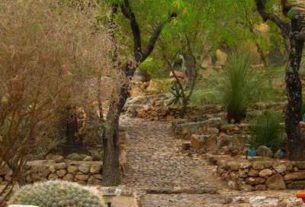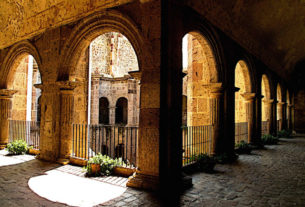At Home in Talpa de Allende, Jalisco
May is a dry month in Mexico. In fact, some folks may call it the drought month before the rainy season begins.
This is the time of year when farmers begin to prepare their fields for planting. The actual planting is done after a couple of good soaking rains. This preparation of the fields is usually accomplished by burning off the brush. There are laws against this and, occasionally, somebody has to pay a hefty fine for breaking the law. If you talk to the older farmer about this, he probably will reply, “My daddy burned and so did his daddy. If it was good enough for them, it’s good enough for me.” The month of May in Jalisco is typically hot, dry and windy. One little runaway fire can create havoc to our environment.

I don’t remember that we studied ecology when I was growing up. I don’t know where our fathers and grandfathers learned that tilling last year’s stalks and vines back into the soil would supply nutrients to this year’s crops. Some of us grew up in Rural Town, USA/Canada. We cut down a tree when we needed firewood for our chimneys and, certainly, we cut our own Christmas trees. Most of us never heard of that ugly word, graffiti. Graffiti does appear on the walls in some of these pueblos, but due to the misspelled English words, I believe most of it is imported from big northern cities. Having said that and trying to take the blame off the local kids, I’ve added a few choice Spanish words to my vocabulary by reading the walls.
Final semester high school ecology students in our towns are calling attention to what we are doing to this planet. One group has planted over four hundred pine trees, tabachines (poinciana) and bougainvillea along the roadsides and river banks. Another group has painted murals on the walls in town depicting how important it is for all of us to care for our ambience. I asked some of these students how they feel when our farmers start burning off the fields to get ready for next planting season or when they see the results of unconscious littering. Bright, pretty smiles faded and all was quiet for a few minutes.
First, one spoke, “The runaway fire damage done to tall, stately pine trees that are nowhere near a planting field is devastating. It hurts that tree and it hurts me and it hurts what I may produce in the future.”
Then, another said, “I feel that littering must be against God’s laws. What one litters with is contaminating our countryside, causing ailments to our eyes, our noses, to our entire bodies. It hurts.”
This conversation reminded me of two old gringos and their dog named Lucy.
Guy and Bill traveled the roads of Mexico for many years looking for a home. They had grown tired of cooking in Nepenthe in Big Sur, bored with the same scenery they had looked at for some thirty-odd years, so they turned in their spoons, tall white hats and aprons. They packed their battered, old blue van and, along with Lucy, hit the road.
They had picked up a smattering of Spanish while living in California and in their previous Mexican wanderings. One time they stopped off long enough in San Miguel de Allende to enroll in an intensive month-long Spanish class. Another time they stopped off long enough in Puerto Vallarta to study more Spanish with a Mexican who was a Baptist preacher. There were not very many Baptist preachers in Mexico at that time, but times change. They also built a house in Puerto Vallarta while they were polishing their Spanish… and that’s another story of its own.
Lucy, the brown and white terrier, never actually attended Spanish classes, but I guess dogs have a language of their own. She traveled with Guy and Bill wherever they went, but she fell in love in Puerto Vallarta.
Come to think of it, maybe she didn’t actually fall in love. Perhaps it was just one of those casual relationships so many seem to enjoy these days. We never even knew the name of the father of her pups, but she produced two litters. Being the typical wanton witch she was, she left all those furkids in Puerto Vallarta. She didn’t really abandon them; they all found good homes, and I’m sure she has great-grandchildren roaming the beaches there now.
Exploring back roads and tiny villages never ceased to intrigue Guy and Bill. Finally, one of those roads brought them to Talpa de Allende and that is where they made their home. They quickly settled into village life and were accepted warmly by the locals.
They were the only two foreigners living in Talpa when they moved here thirty years ago. In fact, they were almost a novelty. Many of the villagers had traveled to El Norte to Los Angeles, Chicago, Denver, New York and even to European cities. It was not that they had never seen a gringo. It was that none had ever lived among them in Talpa before.
The young boys and girls saw an opportunity to learn English and perhaps find a way to the big cities also. They brought one of their teachers to Bill and asked him to give them English lessons. He thought it over for awhile, agreed to come to the school four days a week for four hours a day and teach them English with an Arkansas accent. I don’t care where you live or for how long, you can’t ever get away from that ‘Suthun’ accent. I know. I still run into folks in Puerto Vallarta who are former students of mine and they speak English with a Mexississippi accent.
While Professor Memo was teaching his new charges how to say, “I am going tomorrow” instead of “I was went tomorrow,” word got out that Guy had not completely forsaken his tall, white hat, apron and spoons.
Some of the best cooks in town came and asked him to teach them Gringo Cooking 101. Of course, he was delighted to be in such popular demand and he made some of the storekeepers happy by insisting his students order in cardamom, curry powder, bitter sweet baking chocolate, such spices and condiments the locals had never heard of before, but they were eager to get to know.
Guy teased the women with breads, pastries, jam and jelly recipes. He taught them to appreciate broccoli, mushrooms and Brussels spouts. He planted a garden of butternut squash, okra, dill, basil and chives. They lusted after his recipes, and most especially, whole baked apples wrapped in flaky pie crusts.
What no one was aware of was that, subtly, Guy and Bill were changing the ideals of the future leaders of a mountain village. I’m not sure they were even aware of it themselves at the time.
Bill taught his English students more than grammar. He taught them not to throw their trash into the street. He showed them how to separate the wet from dry garbage. He showed them how to make compost heaps for their own gardens but, most especially, both he and Guy taught the kids how to clean up after themselves.
The old gringo’s former English students are now parents of children who will soon make them grandparents. It is a proud feeling to go on an outing with these kids and see them hustling about to clean a perfect picnic site. It is even more heart-warming to see them leaving a spotlessly clean site when we go home. Heads up old folks, it is time to learn from our youngsters.
Guy’s Gringo Chile Relleno Casserole
As a side dish, allow one chile per person. As a main dish, allow two chiles per person.
Choose chiles poblanos with smooth skins to facilitate peeling. Blister them over an open fire or in an electric oven until the skins are black. Place in a plastic bag for approximately twenty minutes. Peel off the blackened skins, slit down one side to remove seeds and membrane. Seeds make them very bravo, so leave as many in as you desire or take them all out. Some gringo sissies use disposable gloves for this chore.
This recipe will take care of eight to ten chilies. Adjust accordingly.
Lay the chilies in a buttered oven-proof dish. Use cheese of your choice. We use panela, queso fresco or mozzarella in Talpa. Cut into cubes and stuff the chilies. Completely cover them with grated cheese.
Break four eggs into blender jar. Add ¼ cup flour. Blend well. With blender still running, slowly add 1 ½ cup milk and blend until well mixed. Slowly pour over chilies and bake in a 350 degree F oven for 30 minutes. Cover with foil and continue baking for another 30 minutes. Should be like a soufflé when removed from oven. Serve immediately, or cool, cut into squares and serve as a cold botana the next day.


